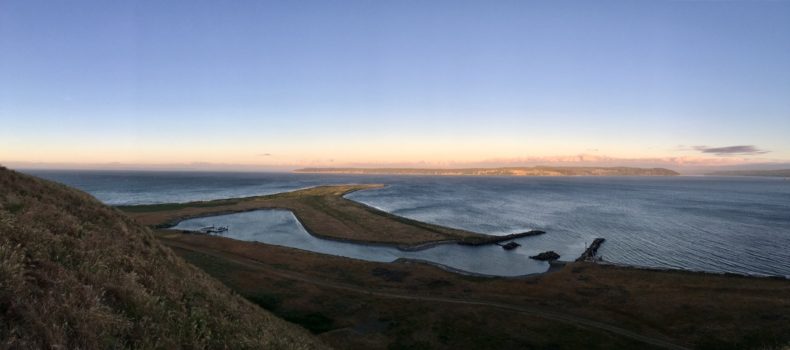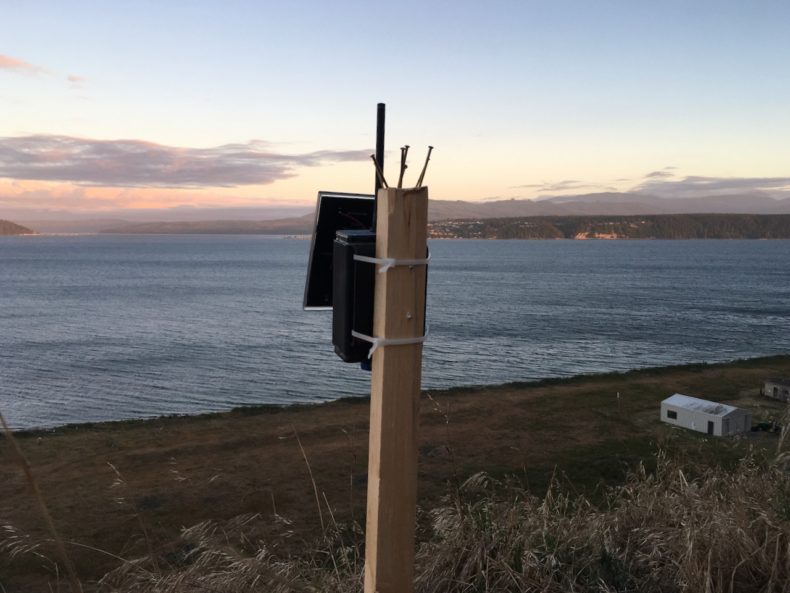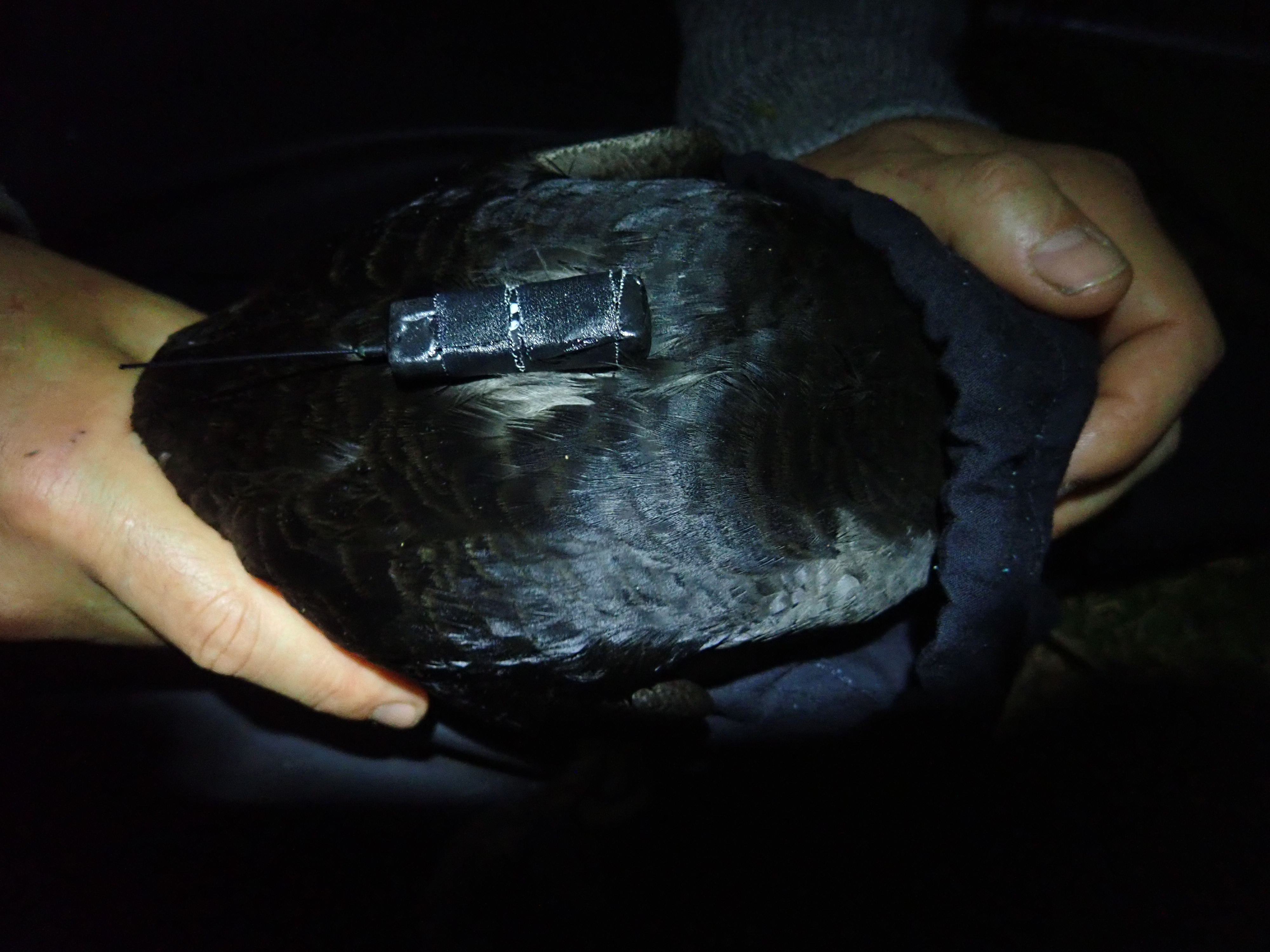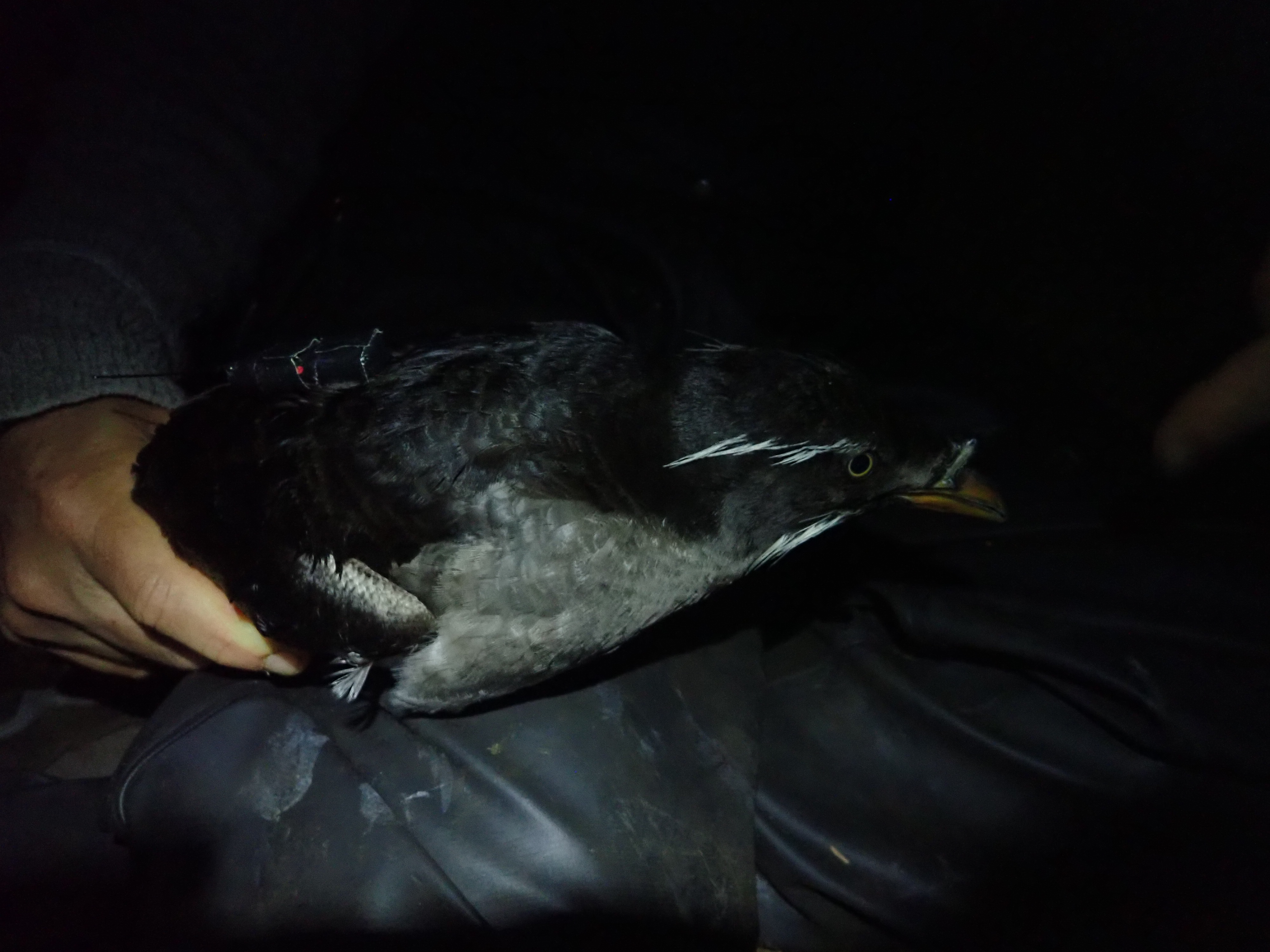
Two days after the summer solstice, more than an hour after sunset, the sky a rich dark blue that is at last starting to deepen to black. Five of us are arrayed about a grassy swale near the top of the southeastern face of Protection Island. We have all our layers on and hunker down to keep out of the stiff wind that blows off the Strait of Juan de Fuca. We are waiting for the rhinoceros auklets to come back.
On a steep slope a short distance away, we have set small purse nets across the entrances of ten burrows, each of which has a chick deep inside. Our plan—more of a hope, really—is that when the chicks’ parents return in an hour or so, bearing meals of small fish, they will entangle themselves in the nets. We will then fetch them and tape small GPS tags to their backs. Those tags will show us where the auklets go to find food in the Salish Sea, sketching lines across the marine spaces as the birds transit hither and yon.
No one has really looked in a concerted way at where the auklets from Protection Island forage. But this seemingly straightforward question—how do rhinoceros auklets at their largest colony in the Pacific Northwest find enough to eat?—quickly splinters into twenty. As the auklets fly out thirty or so miles each day, do they consistently search in more or less one direction, visiting one general area throughout the breeding season? Or do they range widely? Do they go to the same places year after year? What is it that defines their preferred foraging habitats? Banks? Submarine canyons? Other features? Do auklets avoid areas with high ship traffic? Do males and females forage together or apart? And so on and on and on.
The tags we will use to try to answer all these questions amaze me. Even though they are about as heavy as a damp tea bag, the tags can record an auklet’s location every fifteen minutes and are accurate to about five meters. When a bird comes within half a mile of a base station the size of a box of Pop Tarts that we have attached to a wooden stake, the tags will send all their data to it.
So yes: the tags are astonishing little gadgets. Surely more capable than I could ever dream of being at any given task. But there is still the matter of applying them, and no amount of weight-shaving or technical wizardry can spare the auklet that procedure.

We hear the auklets before we see them: the whirr of their quick wingbeats, the crisp chunk as they stall and drop unceremoniously into the grasses so they can scuttle to their burrows. After a few minutes two of our number go to check the nets, their headlamps playing over the swaying grass. All the nets are un-auklet-ed.
Back in the swale, we lie on our backs to stay out of view; thankfully the moon is a waning crescent. The auklets whirr over our heads in a steady stream of small dark shapes. When ten minutes have passed we check the nets again: still no auklets. Ten minutes later: the same. Now the worm of anxiety starts to play in my gut. It becomes clear we have set the nets poorly, that rather than catching the auklets, we are merely tripping them up until they can shake themselves free and fly off.
I decide to take matters into my own hands, so to speak, so I leave the swale and thrash up the hillside to a cluster of burrows. I crouch behind a tuft of grass and wait. Less than two minutes passes before I hear an auklet chunk into the grass near me. I jump up and turn on my headlamp and catch it in the bright beam. It freezes, startled, and I pounce, pinning it to the ground. It drops its bill load—one large Pacific herring and a couple of smaller sand lance—and tries to bite me, but I scoop it up and press it against my body. “I got one!” I yell as I hold the auklet with one hand and with the other put its fish in a plastic bag for later analysis.
“Great!” says Scott, a biologist with the Washington Department of Fish and Wildlife. I carry the auklet down and hand it off to him. He weighs and measures the bird and affixes a small steel band on its leg, so it can be identified in the extremely unlikely event that someone else sees it again in the years to come. When he finishes, he places the auklet in a blue cloth bag and passes it back to me and Amelia, a graduate student from the University of Washington. We two are responsible for the GPS tags.
“Do you want to do this one?” I ask.
“Sure,” Amelia says, so I arrange myself and position the auklet in my lap. I keep the auklet’s head in the blue bag—this helps calm it, in theory—and hold its wings with my thumbs so its back faces out, while I press its feet against my palms so it can’t kick with its long, sharp claws.
Amelia works quickly, quietly. She wedges a wooden stirrer stick under a swath of feathers, lifts them, slides a strip of black tape underneath, and presses the feathers down onto the tape. Moving down a half inch or so, she lifts another swath, slides in another strip of tape. When she has put in four strips of tape, she places the tag atop the feathers and wraps the ends of the tape around the tag, securing it to the auklet’s back before sealing the seams with glue and waiting for it to dry.

Throughout, the auklet is relatively quiet. I sit with it in my hands as its body swells with breath. This is the part of science about which I am most ambivalent. On the one hand I love holding this auklet. I love the intimacy of this encounter—the bird’s smallness and its fragility and its strength, the softness of its feathers that are still damp from the sea. I try never to forget how lucky I am as a human to be able to do this: to come to a national wildlife refuge the public is otherwise forbidden from visiting, to handle this wonderful creature and call it a job of a sort. But I don’t like depriving a chick of a meal, even as I know it is really only half of a meal, since the other parent will also deliver some fish, and tomorrow normal service from both parents will resume. More than that, though, I don’t like knowing the auklet hates and fears me with a greater strength of feeling than I can imagine.
“Okay, it’s ready,” Amelia says once the glue has hardened.
I haul myself up on stiff legs and creaky knees to release the auklet. It struggles and wrests a wing free and flaps frantically. While I try to control the wing, it chomps down on the middle finger of my left hand with all its might. Its bill is small but sharp, and has a slight hook at the end for holding slippery forage fish. It bites and shakes its head, tries for a better grip on my finger, bites again. It grinds its bill and fixes its eye on me as blood trickles down my finger. Watching it work, I think of a notary stamping a piece of paper, impressing its seal.
I carry the auklet to a vantage that opens out onto the strait far below. I make to let it go, but first it has to let me go, and it seems loath to do so. Eventually it realizes that I have loosened my grip, and when it opens its bill I toss it into the air. It flaps off into the night. Behind me I hear Scott say he’s about finished banding the next auklet, so I trudge back to apply the GPS tag.
By 1:30 a.m. we have banded and tagged eight auklets, so we call it a night. My hands are stitched with bloody scratches and gouges. When we have packed up all our accoutrements, I squeeze out a dollop of hand sanitizer and rub it all over, wincing at the sharp sting. Some people wear gloves when they tag birds. I choose not to. In part it is important to me to feel the bird as much as I can, so I can tell how it’s doing, whether its feet are too hot, things like that. But I also think it is only fair to give the auklets a chance to share their thoughts on the whole affair in one of the few ways they can. I at least owe them that, scaring them as we do almost to death, even as we are trying to help them.
